20 years of open source initiative
“It all started when Netscape Communications Corporation published the source code of the Netscape Communicator web browser as open source software. The reason for this act was the competition with the Microsoft Internet Explorer browser, which led to a noticeable decrease in profits. ”That is how we planned to start an article about the 20th anniversary of OSI. But then somehow it was thought that this is far beyond 30 for all of us, and Habr is probably read by those who were just born in 1998, and starting the story from the middle “for the initiates” would be simply unfair. Of course, it all started earlier. Much earlier.
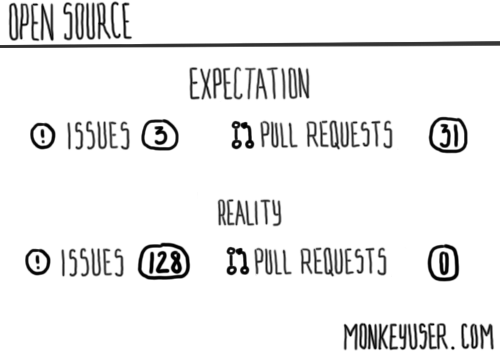
Free Software was born along with the first PCs around the mid-70s, but then it was dry and lost to proprietary software, which was the only foundation of the entire software world. And all the more, there was neither an ideology nor an open source philosophy - in general, “there are few really violent ones, so there are no leaders”. The first scrapping occurred with the advent of the Internet, in which Unix-like systems played a tangible role.
At the same time, the first “leader” appeared and, in an amicable way, “wild”, which was the first to formulate the Free Software concept, Richard Stallman. After the first experiment with free software (driver for the printer), he began to develop his own operating system Hurd. It is clear that he alone would never have coped with it, so in 1983 he created GNU (GNU's Not UNIX), within which, with the direct participation of Stallman, both Emacs (text editor), GCC (compiler), and gmake assembler appeared, and After 2 years of its existence, GNU released a manifesto in which they not only spoke about the project, but also encouraged programmers from all over the world to join the Free Software movement.
')
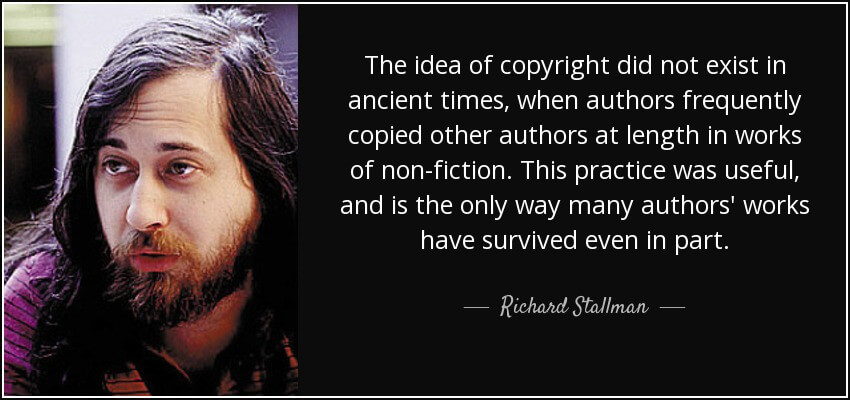
Fossmint.com. Young Stallman and his philosophy.
Many of us are familiar with the next Stallman organization (and many receive their informative newsletters) - the Free Software Foundation. In the meantime, Emacs's text editor has been used by Unipress to create its paid proprietary product. It was a blow from the business - it became clear that the idea must somehow be protected. First came the idea of copyleft (modeled on copyright) - anyone could use the code, modify it and distribute it, but only under the same free conditions. The GNU General Public License (GPL) license has grown from copyleft as a response to the brazen Unipress. In 1985, the FSF formulated four main features by which software can be attributed to free software. Here they are:
By that time, Stallman had supporters and ... opponents who seemed to be in charge of free software, but also wanted to profit at his expense. Stallman was (and still is!) A militant supporter of the ideal world of fully open source software, but some of his followers decided to create half measures and invented open source.
Every war and revolution, as is known, has a reason and an occasion. And if in the business and business world money is most often the cause, then the occasion was one event, again connected with money. And here is the time to remember the beginning of our post.
So, it all started when Netscape Communications Corporation published the source code of the Netscape Communicator web browser as open source software. The reason for this act was the competition with the browser Microsoft Internet Explorer, which led to a marked decrease in profits. By the way, the release of Netscape into the open source in 5 years led to the fact that a new browser appeared - Mozilla Firefox (between times, here is an excellent PDF comparing proprietary and free software - in English.).
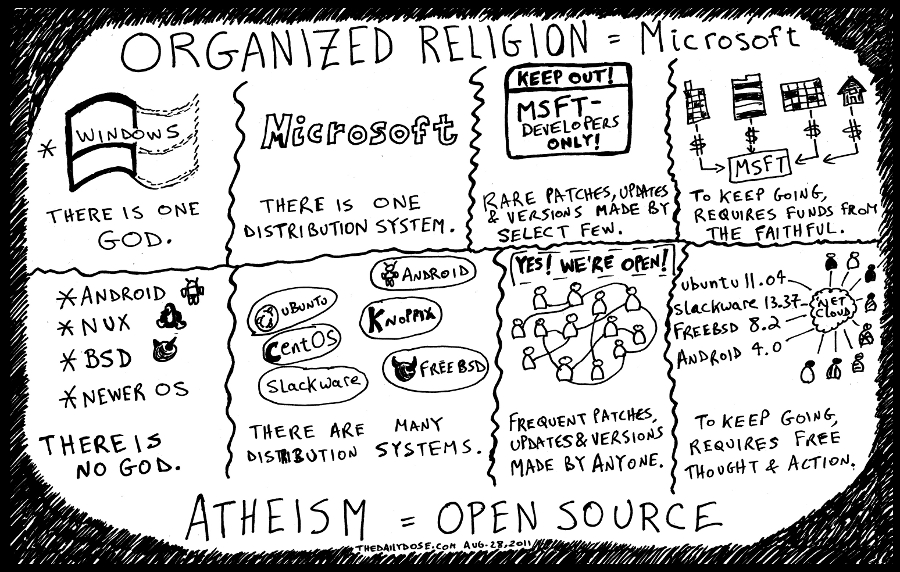
Applied soft science. Source: Google
How did Open Source appear that was supposed to be understandable to everyone? On February 3, 1998, a Free Software conference was held in Palo Alto, which gave rise to the phenomenon (and this phenomenon is social, cultural, economic) open source.
The people gathered at the conference pursued two goals: first, to make the concept of free software more comprehensible and transparent to the broad masses, and second, to untie the thoughts of users from the word "free", which from time immemorial capitalist centuries was interpreted not only as freedom, and more as "free." Well, about as in this picture:

Therefore, one of the participants of the conference, Kristin Peterson, proposed the wording “open source”. Around the same time, Eric Raymond and Bruce Perens founded the Open Source Initiative (OSI) - an organization whose goal was to promote the open source ideology, provide technical support and, of course, monitor the compliance of the practice of using software with free licenses (which to our time has become several ). It is clear that Stallman was outraged by this alignment, accused OSI of having moved from philosophy to development methodology (compare free and open).
What happened next? In principle, everything is expected: the commercialization of certain aspects, the creation of “evil” from the point of view of free software licensing forms (for example, software that can be used in commercial development) and most importantly, the most amazing thing is for what and why today about the 20th anniversary Open Source on Habré is a developer of a proprietary commercial CRM system - open source conquered the world, hundreds of thousands, millions of programmers from around the world joined the movement. Appeared applications, programs, entire systems and individual libraries, operating systems and programming languages. Without open source, there is practically no major project. One of the first open source supported Linux, Sendmail, Perl, Python, Apache. And one of the first projects that showed that free software could become a more successful business was SugarCRM, which received several popular and not-so-forks.
In fact, we know why open source is not worth loving, but don’t write about it in a commemorative article! Be sure to somehow briefly write about the arguments against (exclusively in business solutions).
And finally, two facts about open source:
15 years ago, Steve Ballmer called open source a cancerous tumor, and today Satya Nadella considers something completely different.
Here is what it looks like:
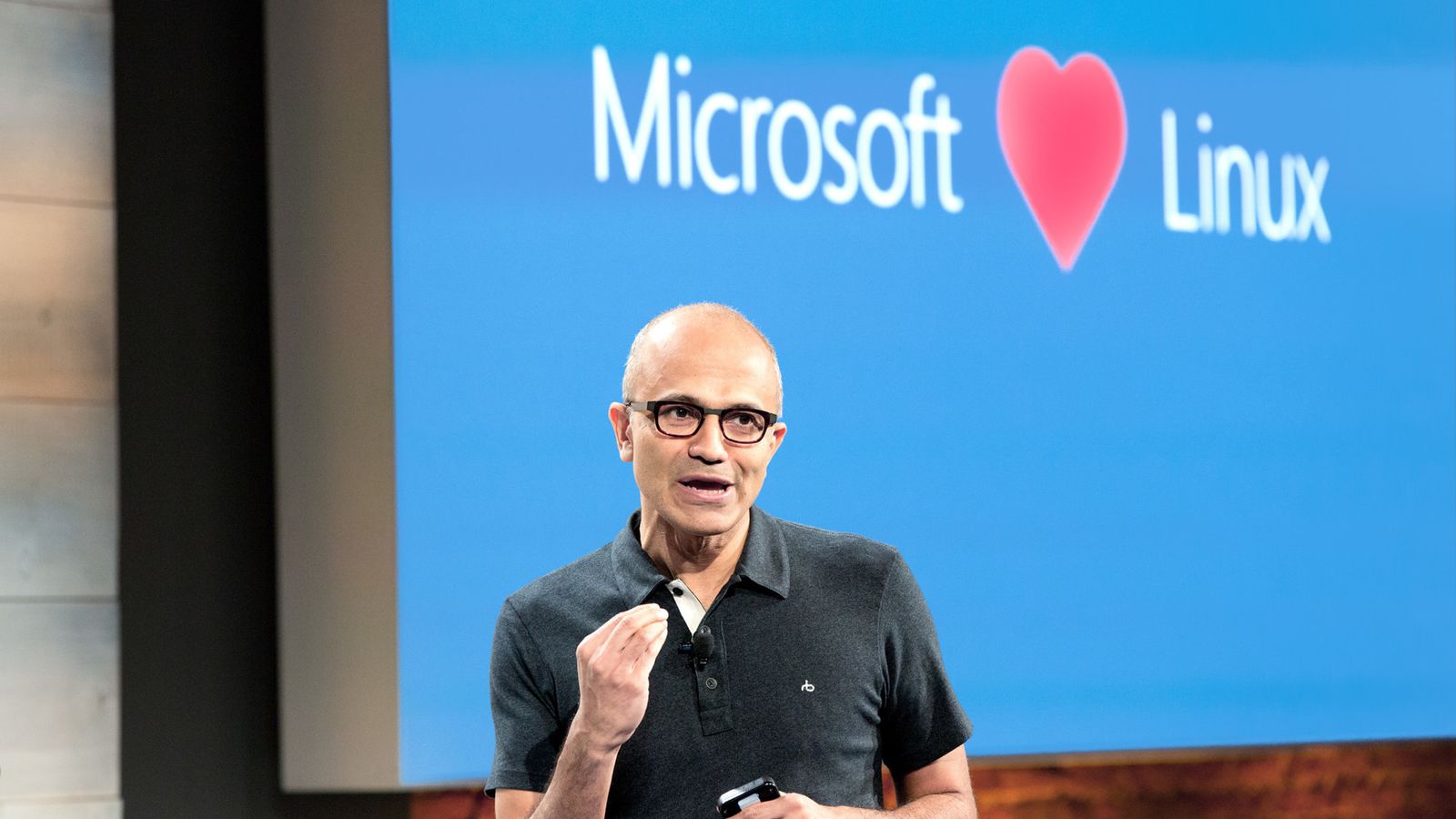
But a great alternative interpretation:
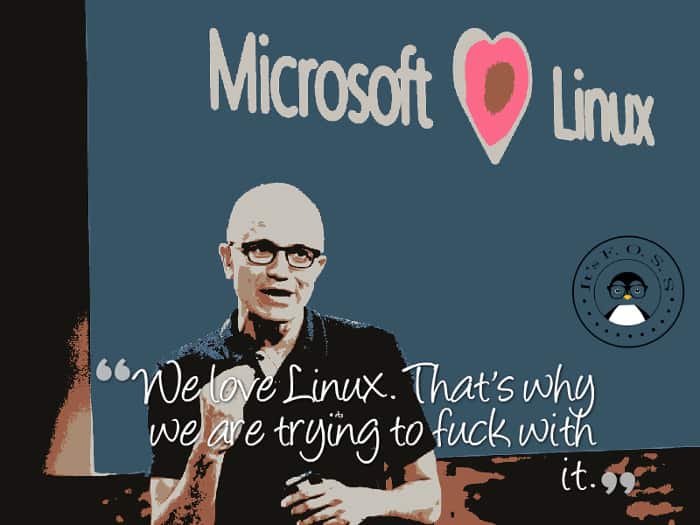
Agree, few people in 20 years from the initiative and eyesore of proprietary software could become the cornerstone of the development and operation of the entire information technology industry.
And today, almost a week late, we congratulate open source on its 20th anniversary and will not even desire development and prosperity - because without it the development of science, business, IT, artificial intelligence, neural networks, space is already impossible. In general, the whole of humanity.
Be open, friends!

Historical background to create OSI
Free Software was born along with the first PCs around the mid-70s, but then it was dry and lost to proprietary software, which was the only foundation of the entire software world. And all the more, there was neither an ideology nor an open source philosophy - in general, “there are few really violent ones, so there are no leaders”. The first scrapping occurred with the advent of the Internet, in which Unix-like systems played a tangible role.
At the same time, the first “leader” appeared and, in an amicable way, “wild”, which was the first to formulate the Free Software concept, Richard Stallman. After the first experiment with free software (driver for the printer), he began to develop his own operating system Hurd. It is clear that he alone would never have coped with it, so in 1983 he created GNU (GNU's Not UNIX), within which, with the direct participation of Stallman, both Emacs (text editor), GCC (compiler), and gmake assembler appeared, and After 2 years of its existence, GNU released a manifesto in which they not only spoke about the project, but also encouraged programmers from all over the world to join the Free Software movement.
')

Fossmint.com. Young Stallman and his philosophy.
Many of us are familiar with the next Stallman organization (and many receive their informative newsletters) - the Free Software Foundation. In the meantime, Emacs's text editor has been used by Unipress to create its paid proprietary product. It was a blow from the business - it became clear that the idea must somehow be protected. First came the idea of copyleft (modeled on copyright) - anyone could use the code, modify it and distribute it, but only under the same free conditions. The GNU General Public License (GPL) license has grown from copyleft as a response to the brazen Unipress. In 1985, the FSF formulated four main features by which software can be attributed to free software. Here they are:
- run the software for any purpose you need;
- change the program according to your needs - in order for this freedom to be realized in practice, there must be access to the source code, since without this it is very problematic to make changes to the program;
- distribute copies, for free or for a fee;
- distribute modified versions of the software so that the community can benefit from all your improvements.
By that time, Stallman had supporters and ... opponents who seemed to be in charge of free software, but also wanted to profit at his expense. Stallman was (and still is!) A militant supporter of the ideal world of fully open source software, but some of his followers decided to create half measures and invented open source.
Every war and revolution, as is known, has a reason and an occasion. And if in the business and business world money is most often the cause, then the occasion was one event, again connected with money. And here is the time to remember the beginning of our post.
OSI good
So, it all started when Netscape Communications Corporation published the source code of the Netscape Communicator web browser as open source software. The reason for this act was the competition with the browser Microsoft Internet Explorer, which led to a marked decrease in profits. By the way, the release of Netscape into the open source in 5 years led to the fact that a new browser appeared - Mozilla Firefox (between times, here is an excellent PDF comparing proprietary and free software - in English.).

Applied soft science. Source: Google
How did Open Source appear that was supposed to be understandable to everyone? On February 3, 1998, a Free Software conference was held in Palo Alto, which gave rise to the phenomenon (and this phenomenon is social, cultural, economic) open source.
The people gathered at the conference pursued two goals: first, to make the concept of free software more comprehensible and transparent to the broad masses, and second, to untie the thoughts of users from the word "free", which from time immemorial capitalist centuries was interpreted not only as freedom, and more as "free." Well, about as in this picture:

Therefore, one of the participants of the conference, Kristin Peterson, proposed the wording “open source”. Around the same time, Eric Raymond and Bruce Perens founded the Open Source Initiative (OSI) - an organization whose goal was to promote the open source ideology, provide technical support and, of course, monitor the compliance of the practice of using software with free licenses (which to our time has become several ). It is clear that Stallman was outraged by this alignment, accused OSI of having moved from philosophy to development methodology (compare free and open).
What happened next? In principle, everything is expected: the commercialization of certain aspects, the creation of “evil” from the point of view of free software licensing forms (for example, software that can be used in commercial development) and most importantly, the most amazing thing is for what and why today about the 20th anniversary Open Source on Habré is a developer of a proprietary commercial CRM system - open source conquered the world, hundreds of thousands, millions of programmers from around the world joined the movement. Appeared applications, programs, entire systems and individual libraries, operating systems and programming languages. Without open source, there is practically no major project. One of the first open source supported Linux, Sendmail, Perl, Python, Apache. And one of the first projects that showed that free software could become a more successful business was SugarCRM, which received several popular and not-so-forks.
Why love open source?
- First and foremost, hundreds of thousands of programmers, enthusiastic professionals who create convenient libraries, tools, and useful programs are working on open source software. This is not just developers, it is a supranational community, united by one goal - to make the world better, life simpler, future more technological. It sounds very pretentious, but if you are not an inhabitant of Habr, but just accidentally got into the article from the search, go to GitHub and look at the number of open source projects - there is open source software in 337 programming languages , including JavaScript, Python, Java, Ruby, PHP, C ++.
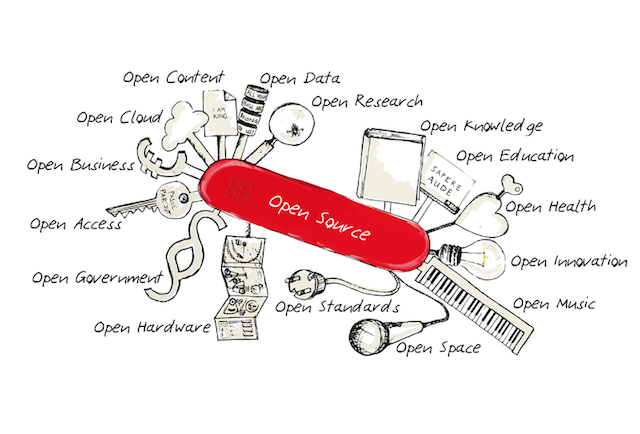
Forbes.com - The ability to find any, even the most unique software for work and education gives great opportunities for small businesses, students and science.
- Open Source projects are a practice for program students, without Mondays and superiors. You can start with small projects, understand, create your own, and then contribute to well-known projects, while classmates dole the prehistoric textbooks. This will give a huge plus both in studies and in the eyes of the employer.
- Active communities ensure that products are kept up-to-date, there is constant debugging, so popular free software is updated frequently and provides users with all the necessary functions.
- Free software can be adapted to your needs - if you have time, your head is on your shoulders and, oddly enough, money (optional). That is, in theory, you can not wait for some vendor to pull features from backlog, but to take open source and modify it yourself.
- Free software makes commercial software better and cheaper for the end user, because open-end components do not fall into the cost price. For example, we use two important open source projects to develop our RegionSoft CRM . The first is the Firebird DBMS, which does not fail us on even the largest scale implementations, the second is the virtual PBX Asterisk, a powerful VoIP system that covers almost all the business needs for telephony and telephony management.
In fact, we know why open source is not worth loving, but don’t write about it in a commemorative article! Be sure to somehow briefly write about the arguments against (exclusively in business solutions).
And finally, two facts about open source:
- The OSI logo is a reference to the letter O (open), which is crossed with a keyhole, the symbol of the unlocked source code. It was created by Colin Vibrok.

- Microsoft stopped fighting open source a while ago, joined the Linux Foundation in 2016, and now even the slogan “Microsoft loves Linux” has appeared. The corporation has already opened source code .NET Core 1.0, PowerShell, Visual Studio Code and Edge. On GitHub, Microsoft leads the list of participants and is ahead of Facebook, NPM and Angular.
15 years ago, Steve Ballmer called open source a cancerous tumor, and today Satya Nadella considers something completely different.
Here is what it looks like:

But a great alternative interpretation:

Agree, few people in 20 years from the initiative and eyesore of proprietary software could become the cornerstone of the development and operation of the entire information technology industry.
And today, almost a week late, we congratulate open source on its 20th anniversary and will not even desire development and prosperity - because without it the development of science, business, IT, artificial intelligence, neural networks, space is already impossible. In general, the whole of humanity.
Be open, friends!
Source: https://habr.com/ru/post/348724/
All Articles